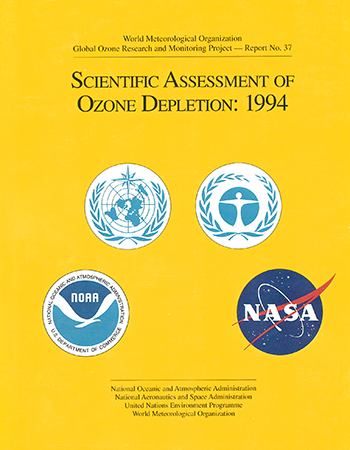Scientific Assessment of Ozone Depletion: 1994

Citations and Copies
The 1994 WMO/UNEP assessment, Scientific Assessment of Ozone Depletion: 1994, contains the understanding of ozone depletion and reflects the thinking of 295 international scientific experts who contributed to its preparation and review. Co-chairs of the 1994 assessment were Dr. Daniel L. Albritton of CSD (formerly the Aeronomy Laboratory), Dr. Robert T. Watson of the White House Office of Science and Technology Policy, and Dr. Piet J. Aucamp of the Department of National Health in South Africa. Other members of the Aeronomy Laboratory made substantial contributions to the report, serving as lead authors, co-authors, contributors, reviewers, coordinating editor, and editorial support staff.
This Ozone Assessment includes three major sections – the Executive Summary, 13 detailed chapters in five parts, and Common Questions About Ozone (a special section):
- Part 1. Observed Changes in Ozone and Source Gases
- Chapter 1. Total and Vertical-Column Ozone (Lead Author: Neil R.P. Harris)
- Chapter 2. Source Gases (Lead Author: Eugenio Sanhueza)
- Part 2. Atmospheric Processes Responsible for the Observed Changes in Ozone
- Chapter 3. Polar Ozone (Lead Author: David W. Fahey)
- Chapter 4. Tropical and Midlatitude Stratosphere (Lead Author: Roderic L. Jones)
- Chapter 5. Tropospheric Ozone (Lead Authors: Andreas Volz-Thomas and Brian A. Ridley)
- Part 3. Model Simulations of Global Ozone
- Chapter 6. Stratospheric Ozone (Lead Author: Malcolm K.W. Ko)
- Chapter 7. Tropospheric Ozone (Lead Author: Frode Stordal)
- Part 4. Consequences of Ozone Change
- Chapter 8. Radiative Forcing (Lead Author: Keith P. Shine)
- Chapter 9. Surface Ultraviolet Radiation (Lead Author: Richard McKenzie)
- Part 5. Scientific Information for Future Decisions
- Chapter 10. Methyl Bromide (Lead Author: Stuart A. Penkett)
- Chapter 11. Subsonic and Supersonic Aircraft Emissions (Lead Authors: Andreas Wahner and Marvin A. Geller)
- Chapter 12. Substitutes for the Long-Lived Halocarbons and Their Degradation Products (Lead Author: R.A. Cox)
- Chapter 13. Ozone Depletion Potentials, Global Warming Potentials, and Future Chlorine/Bromine Loading (Lead Authors: Susan Solomon and Donald Wuebbles)
- Common Questions About Ozone (Coordinators: Susan Solomon and F. Sherwood Rowland)
Executive Summary
The Executive Summary gives a synopsis of major scientific findings of the 13 chapters of the full assessment. This portion includes:
- Preface
- Recent Major Scientific Findings and Observations
- Supporting Scientific Evidence and Related Issues
- Ozone Changes in the Tropics and Midlatitudes and Their Interpretation
- Polar Ozone Depletion
- Coupling Between Polar Regions and Midlatitudes
- Tropospheric Ozone
- Trends in Source Gases Relating to Ozone Changes
- Consequences of Ozone Changes
- Related Phenomena and Issues
- Implications for Policy Formulation
Common Questions About Ozone
The international scientific community included this new section in their 1994 assessment. In it, they answer several of the general questions that are most commonly asked by students, the general public, and leaders in industry and government. After a general introduction about ozone, the questions addressed are:
- How can chlorofluorocarbons (CFCs) get to the stratosphere if they're heavier than air?
- What is the evidence that stratospheric ozone is destroyed by chlorine and bromine?
- Does most of the chlorine in the stratosphere come from human or natural sources?
- Can changes in the Sun's output be responsible for the observed changes in ozone?
- When did the Antarctic ozone hole first appear?
- Why is the ozone hole observed over Antarctica when CFCs are released mainly in the Northern Hemisphere?
- Is the depletion of the ozone layer leading to an increase in ground-level ultraviolet radiation?
- How severe is the ozone depletion now, and is it expected to get worse?